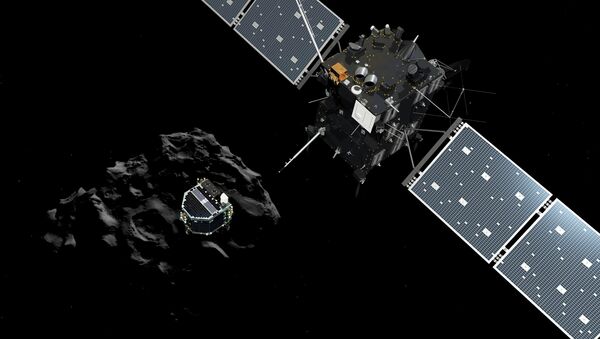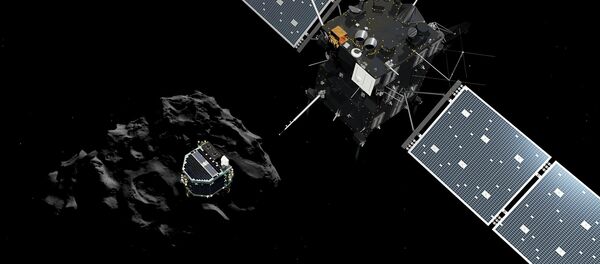MOSCOW, January 5 (Sputnik) – Philae, the probe, which went into hibernation mode soon after making a historic landing on a comet, could revive in March, when Sun rays allow it to recharge its batteries, AFP reports, citing a French official.
Philae landed on a comet, known as 67P/Churyumov-Gerasimenko, on November 12, in what was a first such landing in the history of space exploration. The probe sent volumes of data back to Earth before its battery ran out. It is currently unable to use solar collection panels that charge batteries powering the onboard systems since it landed in the shade.
However, the comet 67P/Churyumov-Gerasimenko is on its way to the Sun, raising hopes that the Philae mission is not over. "We hope that from March, the sunlight will help the robot to recharge its batteries and resume its scientific work," said Le Gall.
Merry Christmas from #67P, 527 million km from Earth! pic.twitter.com/NhUJAzi7Aq
— ESA Rosetta Mission (@ESA_Rosetta) 25 декабря 2014
If that happens, scientists will receive unique data, which Rosetta and Philae collect on their journey with the comet. "We are hoping to get real-time experience at perihelion, on August 13," said Le Gall, referring to the point when the comet will be closest to the Sun. "I am sure we'll see things that we never imagined," he stated.
Philae is the lander unit of parent spacecraft Rosetta. Built and launched in 2004 by the European Space Agency, the mission is studying the comet and its nucleus in order to determine whether comets brought water and simple organic molecules to Earth billions of years ago, paving the way for life.
Greetings! Today [5 Jan] I’m 525 million km from Earth & 392 million km from the Sun… 219 days to perihelion! #LivingWithAComet #67P
— ESA Rosetta Mission (@ESA_Rosetta) 5 января 2015
Apparently, researchers and scientists are not the only ones hoping that Philae will come back to life. The mission has attracted a significant number of followers online, with people using a special hashtag #WakeUpPhilae on Twitter.
@ESA_Rosetta Keep Philae safe, alright? I can't wait until he wakes up. I wuv him x3 #WakeUpPhilae
— Mandelbrot Set (@MathMathFractal) 5 января 2015
@ESA_Rosetta Fantastic! Keep up the great work #pioneer in #space #WakeUpPhilae #MayTheSunFindYou ����������������������������
— Linda Bee (@Linda_b_123) 5 января 2015


